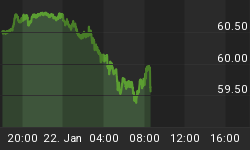Along with its "final" estimate of first-quarter GDP, the BEA also reported its revised estimate of first-quarter corporate profits. Compared with the fourth quarter of 2007, corporate profits from current operations were estimated to have declined 0.3% in the first quarter of 2008 rather than the 0.3% increase originally reported. Looking at total profits on a year-over-year basis, they were up 1.0% in the first quarter. But, as shown in Chart 1, profits generated from domestic operations contracted 4.8% -- the third consecutive quarter in which year-over-year domestically-generated corporate profits contracted. If total profits are increasing year-over-year, but domestically-generated profits are contracting, then it must be that profits generated from overseas operations are increasing. And that is what is shown in Chart 2. Economic growth in the rest of the world has held up better than it has in the U.S. So, some of these profit increases from overseas operations are volume driven. But a depreciating U.S. dollar also plays a role. As the dollar depreciates, profits earned abroad in terms of foreign currencies translate into higher dollar profits when repatriated. On a year-over-year basis, the dollar was down 9.2% vs. other major currencies. So, the weaker dollar is inflating U.S. corporate profits.
Chart 1
Chart 2
As Merrill Lynch's North American chief economist, David Rosenberg, reminds us, it is profits generated from domestic operations that influence domestic hiring. As Chart 3 shows, in recent quarters both financial sector as well as nonfinancial sector domestically-generated profits have been contracting. We bet the contraction in nonfinancial profits would be even more severe if energy corporation profits were excluded. One takeaway here is look for more firing rather than hiring over the remainder of the year as a result of weak domestically-generated profits. I believe that domestically-generated profits going forward will be adversely affected by slower growth in physical volumes and squeezed margins due to the inability to pass on to the final purchaser very much of the higher commodity-input price increases.
Chart 3
First-Quarter GDP - "Final" Estimate
The table below traces the revisions to first-quarter GDP. In real terms, growth in real GDP went from 0.6% annualized in the advance estimate, to 0.9% in the preliminary estimate, to 1.0% in the final estimate. These are insignificant revisions. You can be the judge by perusing the revisions at your leisure in the table below.

One of my readers' questions generated an hypothesis that real GDP growth could be biased upward if nonfarm payrolls also are biased upward. Nonfarm payrolls are an important input into the calculation of other variables, which, in turn, are inputs into the calculation of real GDP. I believe that nonfarm payroll growth is being overstated because of the birth/death adjustment. As Chart 4 shows, in the 12 months ended May, total nonfarm payrolls increased 104 thousand. But excluding the birth/death adjustment, total nonfarm payrolls contracted by 726 thousand. If the contribution of the birth/death adjustment to the change in nonfarm payrolls were relatively constant, I would not be suspicious of the establishment employment data. But the contribution started moving up in 2007 as economic growth slowed and skyrocketed to 798% in the 12 months ended May 2008 (see Chart 5). If nonfarm payrolls have been significantly overstated of late because of a flawed birth/death adjustment, then it is a good bet that real GDP also has been overstated.
Chart 4
Chart 5
















